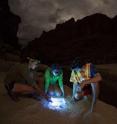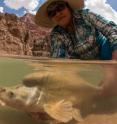River food webs threatened by widespread hydropower practice
Related images
(click to enlarge)
The decline of aquatic insects downstream from some hydroelectric dams has been linked to a widespread practice known as hydropeaking, whereby river flows are increased during the day when electricity demands are large, according to a new study led by the U.S. Geological Survey, along with researchers from Oregon State University, Utah State University and Idaho State University. Findings show it may be possible to mitigate these negative effects by using alternative hydropower practices. Aquatic insects play an essential role in river food webs and are the main food source for countless species of fish, birds, bats and other wildlife. This study identified how abrupt water level changes affect aquatic insects in every stage of life, which is an important step toward understanding how to potentially improve river health downstream of hydropeaking dams throughout the world.
The research was based in part on a large citizen science project with more than 2,500 insect samples taken on the Colorado River in the Grand Canyon, downstream of Glen Canyon Dam. This dataset was collected almost entirely by river guides, educational groups, and other citizen scientists. Researchers also tested the effects of abrupt water levels changes on river health by comparing insect diversity across 16 large dammed rivers in the western United States that vary in the degree of hydropeaking. The full report is available online in the journal BioScience.
"For the first time, this study determines the ecological impacts of hydropeaking separated from other dam-imposed stressors, and identifies the specific cause-and-effect relationships responsible for biodiversity loss below hydroelectric dams," said Ted Kennedy, USGS scientist and lead author of the study. "These results may help resource managers improve river health while still meeting societal needs for renewable hydroelectricity."
Hydropower provides around 19 percent of the world's electricity supply, far exceeding solar, wind, and other renewable sources combined. Many hydroelectric dams are operated using hydropeaking, where water releases can vary by a factor of 10 or more within a day. These large hourly changes in river levels create artificial tides along river shorelines to which freshwater organisms are not adapted.
Insects that lay their eggs near the shoreline of streams are particularly vulnerable to impacts from hydropower dams. Ecologically important insects groups, such as many species of mayfly, stonefly or caddisfly, lay their eggs attached to rocks or vegetation slightly below the water surface, where they soon hatch. If water levels rapidly drop and expose the eggs, they can dry out and die before hatching.
"These large daily rises and peaks in river flows due to hydropower dams are not normal. Prior to the construction of dams, there were almost no major daily changes in river levels in places like the Grand Canyon," said David Lytle, Oregon State University professor and co-author of the paper. "This can interrupt the egg-laying practices of some species, and the impact of this was poorly appreciated. Until now, no one really looked at this aspect, and our results show that it causes serious problems for river health."
The virtual absence of mayflies, stoneflies and caddisflies from the Colorado River in Grand Canyon has puzzled scientists for decades. This study demonstrates that hydropeaking operations from Glen Canyon Dam are partially responsible. Mitigation measures for managers to consider might include leaving river levels low and stable at times when impacts on power production at Glen Canyon Dam would be minimal, for example on weekends. This could allow insects a few days to lay their eggs with success.
"If mitigation flows are successful, a more diverse community of aquatic insects should improve the health of the Colorado River ecosystem in Grand Canyon, including the largest remaining population of endangered humpback chub," said Kennedy.
The success of this project is largely due to the wide array of river guides, boaters and youth that contributed to an unprecedented database of aquatic insects. These citizen scientists collected more than 2,500 samples on the Colorado River in the Grand Canyon over a three-year period. The partnership with Grand Canyon Youth alone provided more than 150 samples, and their efforts are featured in this video. This large dataset allowed scientists to draw scientific conclusions that otherwise wouldn't have been possible.
"Many urgent questions in ecology remain unanswered, because scientists are bumping up against data limitations where it is impossible for them to collect sufficient data to answer complex questions across large landscapes," said Kennedy. "This study is a powerful example of how citizen science collaborations can fundamentally advance learning and generate important new insights."
Source: US Geological Survey
Articles on the same topic
- Hydropeaking of river water levels is disrupting insect survival, river ecosystemsMon, 2 May 2016, 19:53:26 UTC
Other sources
- Hydropeaking of river water levels is disrupting insect survival, river ecosystemsfrom Science DailyMon, 2 May 2016, 19:50:41 UTC
- River food webs threatened by widespread hydropower practicefrom PhysorgMon, 2 May 2016, 19:11:11 UTC
- Hydropeaking of River Water Levels Is Disrupting Insect Survival, River Ecosystemsfrom Newswise - ScinewsMon, 2 May 2016, 18:40:57 UTC


